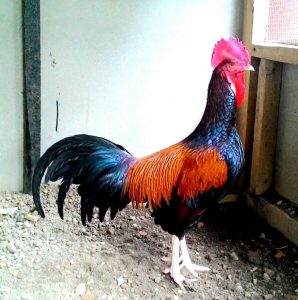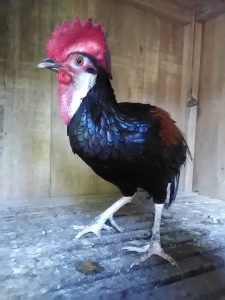 Overview
Overview
The Bekisar chicken is the hybrid offspring of the red junglefowl from Java in Indonesia and the green junglefowl. They are bred for their voice, which is a distinct shriek.
The roosters are used on canoes and are hoisted up the mast in a small basket; once up there they’ll continually shriek and it is said that their voice can be heard for up to two miles out at sea.
Females of this breed are mostly in fertile and to achieve fertility in females the male Bekisar needs to be bred several times with other domestic chickens. Their weight is variable as they are a hybrid breed.
Eggs
Size
Medium sized
Color
Blue, violet, green or gray colored eggs
Production per year
Varies depending on the lineage of the chicken
When do they start laying eggs?
From 6 months
Bearded d’Uccle Characteristics
Temperament / Are they good as pets?
These birds are only semi-domesticated so should not be kept as pets.
How do I tame Bearded d’Uccle chickens?
Taming these chickens is unadvisable as they are only semi-domesticated.
How many do I need to buy?
A small flock of these would be best, try buying 4 as you don’t want to overcrowd them as this causes fights.
How much space do they need?
They need lots of space, free range birds need at least 250 square feet per bird, but we recommend a lot more especially for this breed.
Will they mix with my other chickens?
They shouldn’t be put into another flock as these are primarily wild birds.
Appearance
An exotic breed with bright exotic and shiny feathers to match. They come in three color varieties but the most popular is a glossy beetle green plumage. They have a single comb and are somewhat smaller than the average male chicken.

Feeding
What should I feed them?
When you first get your chickens you should feed them growers mash as it is finer and therefore easier to ingest. This has all the good stuff they need for their development and typically has around 19{cfcd481556a8b43fba6af451761032bd323e94372a0c1e607} protein.
At 6 weeks they can eat chicken pellets, which is a larger form of chicken feed in pellet shape, containing 15-16{cfcd481556a8b43fba6af451761032bd323e94372a0c1e607} protein.
When they get to 18 weeks you need to slowly start introducing layers mash or layers pellets into their diets. This has around 16{cfcd481556a8b43fba6af451761032bd323e94372a0c1e607} protein content and everything they need nutrition wise to help them make eggs.
How much should I feed them?
The average chicken eats ¼ of a pound (113g) a day, but this number can range from 2.9oz (80g) to 4.2oz (120g). When they reach maturity try feeding them ¼ of a pound and check how much they eat of this, or if they eat this very quickly, then adjust your feed weight accordingly.
The best way to do this is to feed them at meal times so you can accurately check their consumption. Once you’ve settled on an amount you can leave the feed in the feeder for them to eat as they please.
What can’t they eat?
There are lots of different foods that should not be eaten by chickens, the main two being chocolate and beans. Chocolate and beans have theobromine and phytohemagglutinin in which can induce heart problems and can actually kill them.
Food that has gone moldy shouldn’t be fed to chickens as if its not fit for human consumption then it’s probably not fit for your chickens.
In the UK it’s against the law to feed any leftovers from your kitchen.
What do I need to keep chickens?
A coop that has at a very minimum 1.1m2 or 11 square feet per chicken. You should have an area that has at least 250 square feet per chicken, the more space the better as you want to give them space so that they can run away if a fight occurs.
To prevent any chickens being killed by predators you should have a fence that goes around and over the coop and that has been sunk into the ground so that nothing can dig under it to get access to your chickens.
In the coop you should have a perch for each chicken to sleep on and there needs to be wooden boxes that they can lay eggs in.
They need grit on hand that they can use for egg production. They also need constant access to water, the water container needs to be kept away from the sun as they prefer cold water. The container shouldn’t be tippable and high enough that they can’t step into it.
